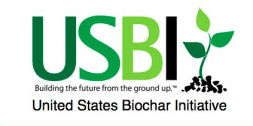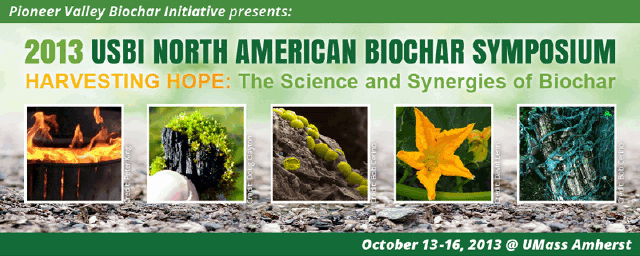Feedstocks & Production
Unique Biochar Phenomena
Zhenyu Wang presentation
Unique Biochar Phenomena McLaughlin.pdf (3036 kB)
Hugh McLaughlin presentation
Location
CC 163
Start Date
15-10-2013 10:00 AM
End Date
15-10-2013 11:20 AM
Session Description
Production of Biochar: Multi-Scale Wood Pyrolysis Chemistry for Biochar Optimization Paul J. Dauenhauer, University of Massachusetts Amherst
Utilization of non-food, lignocellulosic biomass such as trees and grasses provides unprecedented opportunity to sustain a lifestyle which benefits from renewable plastics, chemicals and fuels and relies heavily on agriculture. These feedstocks are rich in the carbohydrate polymers cellulose and hemicellulose, which can be broken down by pyrolysis to a solid product, called biochar, which has significant benefits for soil and farming. Production of biochar relies on a chemical process called pyrolysis, whereby the biopolymers of lignocellulosic feedstocks thermally degrade to vapors and solid char. Our research aims to understand the chemical reaction pathways that produce biochar from woody biomass and to integrate these chemical mechanisms within heat transfer models capable of describing the biochar process within wood fibers. Using a new experimental technique called ‘thin-film pyrolysis,’ we reveal that biochar is produced by two competing pathways: (1) direct dehydration of intact biopolymers, and (2) indirect re-formation of intermediate polymer fragments. These chemistries are studied within porous wood fibers using a diffuse reflectance spectroscopy technique capable of characterizing spatio-temporal compositional profiles of carbohydrates within wood fibers during the biochar reaction process. This research provides fundamental insight into the development of new chemical reactors which exhibit increased yield to higher quality biochar.
INFLUENCE OF PYROLYTIC TEMPERATURE ON NUTRIENT AVAILABILITY IN PLANT-DERIVED BIOCHAR: Z. WANG
This session will discuss the influence of pyrolytic temperature on nutrient availability based on research using biochars produced from giant reed, and the release of N, P and K. With increasing temperature, more N was lost and residual N was transformed into heterocyclic-N, resulting in less available NH4 from high temperature biochars, whereas no P and K losses were observed. P was transformed less soluble minerals, resulting in a reduction in available P in high temperature biochars. The available K content in biochars increased with increasing pyrolysis temperature. The results indicated that the low-temperature biochar produced from giant reed may be a good amendment for improving the availability of nutrients in acidic soils exhibiting N, P and/or K deficiency.
BIOCHARS FROM ANIMAL MANURE AS ADSORBENTS FOR ENVIRONMENTAL REMEDIATION
Isabel M. Lima, K. Thomas Klasson, Minori Uchimiya
USDA, Agricultural Research Service, New Orleans, LA
ABSTRACT
Water quality and public health impacts of animal manure produced at large concentrated animal facilities prompted the need for viable solutions for their conversion and reuse. There are a myriad of carbonaceous precursors that can be used advantageously to produce chars, due to their low cost, availability and intrinsic properties and our laboratory at the Southern Regional Research Center, as part of the Agricultural Research Service of the U.S. Department of Agriculture, has shown that it is feasible to convert animal manure into chars and activated chars used for heavy metals remediation. Toxic metals contamination of various water sources is a significant problem in many parts of the United States. Both chars and activated chars produced under different processing conditions and undergoing different pre- and post treatments have been characterized for their physical properties and most importantly their ability to adsorb metal ions. These properties depend on the source of the manure, and in general it has been determined that poultry manure-based chars and activated chars far exceed those sourced from coal, wood or coconut shells, in their ability to remove heavy metals from solution. Acid washing or water rinsing treatments to reduce ash content had no significant effect in the ability of the activated char to adsorb copper ions, however significantly affected surface area, pH, and ash and carbon contents. Strong positive correlations were found between copper uptake and concentration of certain elements in the activated char such as phosphorous, sulfur, and calcium. An estimated cost of production for the manure based value added chars and activated chars under different post treatment scenarios is also reported.
Unique Biochar Phenomena
CC 163
Production of Biochar: Multi-Scale Wood Pyrolysis Chemistry for Biochar Optimization Paul J. Dauenhauer, University of Massachusetts Amherst
Utilization of non-food, lignocellulosic biomass such as trees and grasses provides unprecedented opportunity to sustain a lifestyle which benefits from renewable plastics, chemicals and fuels and relies heavily on agriculture. These feedstocks are rich in the carbohydrate polymers cellulose and hemicellulose, which can be broken down by pyrolysis to a solid product, called biochar, which has significant benefits for soil and farming. Production of biochar relies on a chemical process called pyrolysis, whereby the biopolymers of lignocellulosic feedstocks thermally degrade to vapors and solid char. Our research aims to understand the chemical reaction pathways that produce biochar from woody biomass and to integrate these chemical mechanisms within heat transfer models capable of describing the biochar process within wood fibers. Using a new experimental technique called ‘thin-film pyrolysis,’ we reveal that biochar is produced by two competing pathways: (1) direct dehydration of intact biopolymers, and (2) indirect re-formation of intermediate polymer fragments. These chemistries are studied within porous wood fibers using a diffuse reflectance spectroscopy technique capable of characterizing spatio-temporal compositional profiles of carbohydrates within wood fibers during the biochar reaction process. This research provides fundamental insight into the development of new chemical reactors which exhibit increased yield to higher quality biochar.
INFLUENCE OF PYROLYTIC TEMPERATURE ON NUTRIENT AVAILABILITY IN PLANT-DERIVED BIOCHAR: Z. WANG
This session will discuss the influence of pyrolytic temperature on nutrient availability based on research using biochars produced from giant reed, and the release of N, P and K. With increasing temperature, more N was lost and residual N was transformed into heterocyclic-N, resulting in less available NH4 from high temperature biochars, whereas no P and K losses were observed. P was transformed less soluble minerals, resulting in a reduction in available P in high temperature biochars. The available K content in biochars increased with increasing pyrolysis temperature. The results indicated that the low-temperature biochar produced from giant reed may be a good amendment for improving the availability of nutrients in acidic soils exhibiting N, P and/or K deficiency.
BIOCHARS FROM ANIMAL MANURE AS ADSORBENTS FOR ENVIRONMENTAL REMEDIATION
Isabel M. Lima, K. Thomas Klasson, Minori Uchimiya
USDA, Agricultural Research Service, New Orleans, LA
ABSTRACT
Water quality and public health impacts of animal manure produced at large concentrated animal facilities prompted the need for viable solutions for their conversion and reuse. There are a myriad of carbonaceous precursors that can be used advantageously to produce chars, due to their low cost, availability and intrinsic properties and our laboratory at the Southern Regional Research Center, as part of the Agricultural Research Service of the U.S. Department of Agriculture, has shown that it is feasible to convert animal manure into chars and activated chars used for heavy metals remediation. Toxic metals contamination of various water sources is a significant problem in many parts of the United States. Both chars and activated chars produced under different processing conditions and undergoing different pre- and post treatments have been characterized for their physical properties and most importantly their ability to adsorb metal ions. These properties depend on the source of the manure, and in general it has been determined that poultry manure-based chars and activated chars far exceed those sourced from coal, wood or coconut shells, in their ability to remove heavy metals from solution. Acid washing or water rinsing treatments to reduce ash content had no significant effect in the ability of the activated char to adsorb copper ions, however significantly affected surface area, pH, and ash and carbon contents. Strong positive correlations were found between copper uptake and concentration of certain elements in the activated char such as phosphorous, sulfur, and calcium. An estimated cost of production for the manure based value added chars and activated chars under different post treatment scenarios is also reported.



Bio and Photo
Paul Dauenhauer is director of the University of Massachusetts Reaction Engineering and Catalysis Laboratory and Assistant Professor of Chemical Engineering at the University of Massachusetts Amherst. Paul received his B.S. in Chemistry and Chemical Engineering from the University of Wisconsin Madison in 2004. In 2008, he received his Ph.D. in Chemical Engineering from the University of Minnesota with a focus on catalytic reforming of biomass advised by Professor Lanny Schmidt. Paul has also worked for the Dow Chemical Corporation as a Senior Research Engineer and Cargill, Inc. He currently serves as Thrust Leader of the DOE-funded Catalysis Center for Energy Innovation, associate editor of Chemical Engineering Science, and manager of the Waste-to-Energy engineering program at UMass. His work focusing on catalytic biomass conversion has been recognized for its achievements in renewable biofuels and chemicals, and Professor Dauenhauer has received the NSF-CAREER, the Dept. of Energy Early Career, and the 3M Nontenured Faculty awards supporting his research efforts.